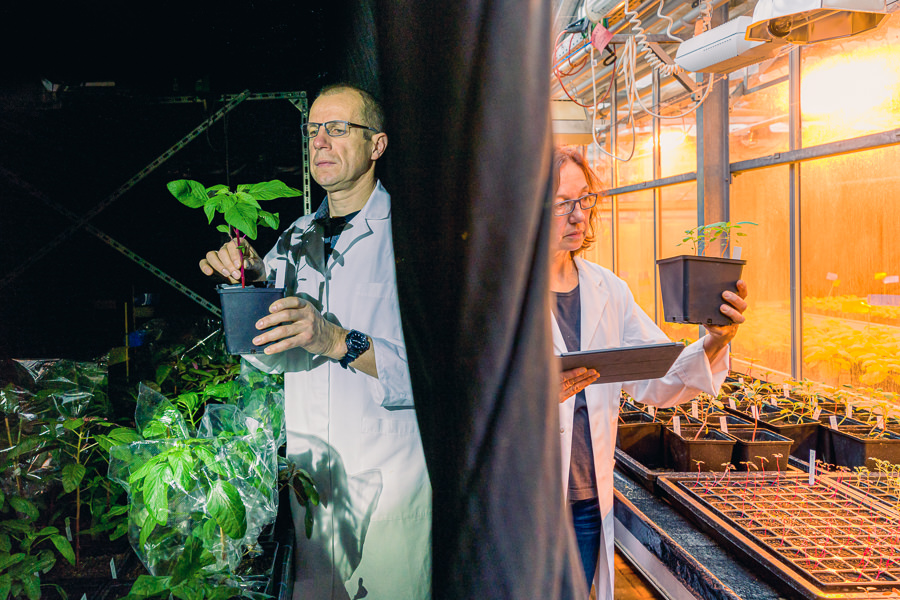
From Farm to Fork: Cultivating Sustainable Food
According to the Food and Agriculture Organization of the United Nations (FAO), livestock production uses up 77 % of agriculturally used land on the planet. It is also a major driver of climate change. The University of Hohenheim wants to ensure food security and a healthy planet for the generations to come, that’s why our scientists work hard to find a way out of this situation.
Beef, Health, and the Planet: Can We Have It All?
- Meat is a good source of protein, although it is not the only one. We need to eat protein for a healthy diet.
- Meat and its production are an economic factor for many countries in the world, thus feeding people in a double sense: From Wallet to Belly
- Meat is loved and consumed by lots of people on the planet whenever they can afford it.
Today's methods of meat and feed production have many negative impacts on our lives and our planet.
Growing world population and food security
By today’s estimates, food and feed production is responsible for one quarter of the world’s greenhouse gas emissions. In order to fill all people’s bellies, the United Nations has projected that food production from plants and animals will need to increase by at least 70 % by the year 2050 (compared to 2009).
If we simply produce more food using our current farming methods, this will lead to more greenhouse gases polluting the environment and causing climate change. Consequently, we have to make an effort so that farming becomes more efficient to ensure equal access to a healthy diet for everyone by improving (protein) crop yields everywhere in the world.
Land use
Today, almost half of the habitable land is used for agriculture. Livestock occupy much of the world’s land for living and feeding, leading to competition between feed and food: Land used to produce feed for livestock is lost to crops for human consumption.
Intensive farming
To grow rich agricultural products, we use fertilizers, lots of fertilizers. The great idea behind fertilizing is to increase crop yields and the amount of raw protein in the crop. Fertilizers contain nitrogen, phosphorus, and potassium. Potassium is important for the overall plant health and phosphorus is involved in plant growth. Nitrogen is a key component of amino acids, proteins, and enzymes that are essential for plant functioning. However, modern agriculture is intensive and uses large amounts of fertilizers to produce high crop yields.
Scientists have estimated that the nitrogen transfer efficiency of fertilizers is only 30 %. Nitrogen transfer efficiency, or NTE, is a measure of how effectively nitrogen is transferred from one stage to another. A NTE rate of 30 % means that only one third of the nitrogen in the fertilizer is used by the plant for its protein production. The other 70 % of the nitrogen pollute the environment. Nitrogen and its compounds end up in the soil, the groundwater, and the air. Too much nitrogen can cause dangerous algae blooms in lakes, it can lead to harmful nitrates in drinking water, and in the air it can react with other pollutants to form particles which make it more difficult for us to breathe. This is why it is so important that plants use the nitrogen in fertilizer as efficiently as possible, ensuring that as little as possible ends up in the environment.
What can be done to ensure that eating meat will still be possible in the years to come?
- It starts in the field: Agriculture Rebooted
Eating habits and lifestyle have managed to get us and the planet into a terrible mess. Find out about new methods in animal husbandry and old plants revisited. - Livestock 4.0: An Omnivore’s Dream
Humans can eat plant-based and animal-based foods alike. But can we still eat meat in the future? Find out about our efforts for precision nutrient management and microbiome research. - Basic Research: Understanding How Plants Work
Drought stresses or viral diseases of plants are a major threat to global food security. At the University of Hohenheim scientists collaborate with colleagues everywhere to get to the root of the problem. If we knew more about how plants really worked inside, we could make them more resistant and increase yields.
Research with us
The University of Hohenheim is Germany’s leading research facility in agricultural research and food sciences, as well as strong and unparalleled in natural, social, and communication sciences.
- Researchers of Proven Excellence
Our scientists demonstrate exceptional skills, knowledge, and achievements. - Strong Focus on Research
We are very well networked and have a unique research profile. - Scientific Research facilities
The University of Hohenheim accommodates various institutions whose structures enable joint research and teaching activities, thus creating the optimal conditions for conducting outstanding research and then transferring it outside of the university. - Dedicated Portal for Early Career Researchers
We are strongly committed to qualification in the early stages of scientific careers. - Innovation and Transfer
We promote intensive cooperation between scientists, private companies, and other societal actors. - Scientific Integrity at the University of Hohenheim
The University of Hohenheim, as a center for research, teaching, and the promotion of early career researchers, undertakes to create and continuously develop the suitable framework conditions for anchoring the culture of scientific integrity and ethics in daily scientific practice. - Professorial Appointments
Our Professorial Appointment Portal offers help for all parties involved throughout the whole process of professorial appointments. - Cooperations
On all levels, the University of Hohenheim networks with universities and research institutions with outstanding international reputation. - Research Promotion
Professional and practical support and assistance through application processes for third-party funds.